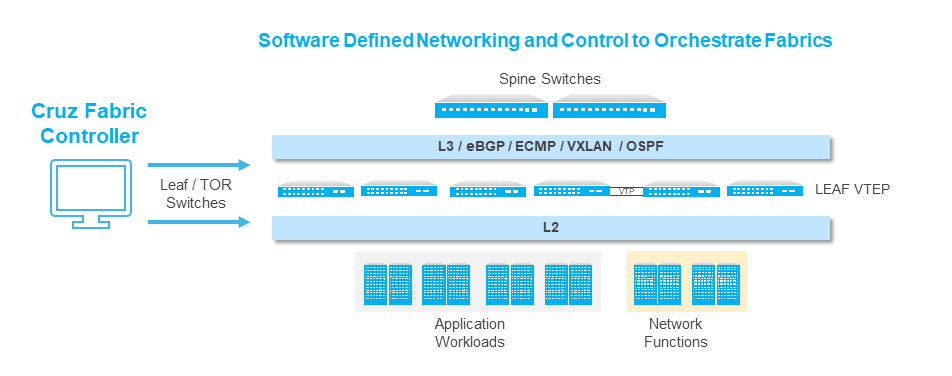Cruz Fabric Controller orchestrates SONiC fabrics across your local or remote data center, remote edges, and other sites.
Managing, monitoring, and configuring numerous switches in any environment can be challenging. Add the complexity of L2/L3 fabrics with Spine and Leaf nodes, overlays like VXLAN, and device-by-device management becomes time-consuming and ineffective. For instance, if you need a new VLAN, you simply want to update the fabric without touching various elements in the fabric, CLI syntax, or order of operations.
The Cruz Fabric Controller provides a solution to manage the fabric as a single entity. Its intent-based networking capabilities make delivering sophisticated network services for large and small customer environments simple. And Cruz Fabric Controller offers true SDN and control to orchestrate fabrics from a single-pane-of-glass.
Cruz Fabric Controller adds to Cruz Operations Center’s (CruzOC) netOps and resource management. With Cruz Fabric Controller and CruzOC combined, you can deploy and update fabrics, manage, monitor, and maintain fabrics, and automate operations across the entire fabric topology. Together, they provide a single console management product for managing data center and network operations of converging infrastructures.
Watch a quick explainer video
>> Download Solution Note
>> Schedule A Demo
See More Dorado SONiC Solutions
>> Enterprise SONiC from Broadcom
>> Vertically Integrated Solution for Open Networking (Hardware + Sofware + Services and Support)
Configure
Monitor
Automate

Key Features
Fabric Monitoring: Track CPU, MEMORY Disk, KPI, and fabric metrics.
Fabric Visualization: Topology maps and geographic mapping let you visualize your fabric links, physical and logical topology and view fabrics by location.
Reporting: Report on inventory, firmware versions, port or interface utilization, and flow data by fabric.
Traffic Flow: Capture applications, protocols, conversations, and endpoints across the fabric.
Automation: Schedule or trigger action workflows or rules or to auto-configure the fabric. Use Pre-built Templates to automate common deployment and configuration tasks from a single user interface to quickly define, provision, and deploy configurations for an entire fabric topology.
Software Lifecycle Management: Apply corporate-wide applications of software updates across fabrics and other devices with dependency validation for network functions, computer processes, and applications. Track fabric elements, service tags, serial numbers, OS versions, and warranty status.
Alarm, Event, and Syslogs: Capture fabric information for deeper analytics, automated notifications, and fabric history.
Intent Based: Network administrators can establish a desired outcome, and Cruz determines the best methods to accomplish this set goal.
Single Pane-of-Glass: Manage system- wide fabric and any managed resource through their full lifecycle via a single interface.
Multi-vendor / Multi-platform: Besides fabrics, configure, manage, and monitor adjacent network technologies like routers, switches, firewalls, servers, clients, IOT, storage, and more.
Asset Management: Manage greenfield and brownfield fabric installations and deployments as a single entity for performance, root cause visibility, and reporting.
Active Security Compliance: Validate fabric configurations, change auditing, and automated compliance enforcement for security policies.
Low-touch fabric Deployment or updates: Accelerate rollout of new fabrics or additions of Leaf with automated resource and network configuration.
Pre-built Design Templates: Sample topologies include: Two tier VLT Fabric L/S, Layer 3 fabric with OSPF, L2/L3 Fabric with VLAG and OSPF, Layer 3 fabric with BGP, VXLAN Overlay with BGP EVPN, LAN/SAN Fabrics, MCLAG
Ecosystem Integration: OPEN API's for easy northbound and southbound integration.
Key Benefits
- Improve efficiency
- Minimize or eliminate daily operational complexity
- Expedite fabric deployments
- Reduce the time it takes to rollout fabric updates or other configuration changes
- Eliminate operator error and misconfiguration
- Validate fabric configuration and design
- Visibility to fabric inconsistencies

